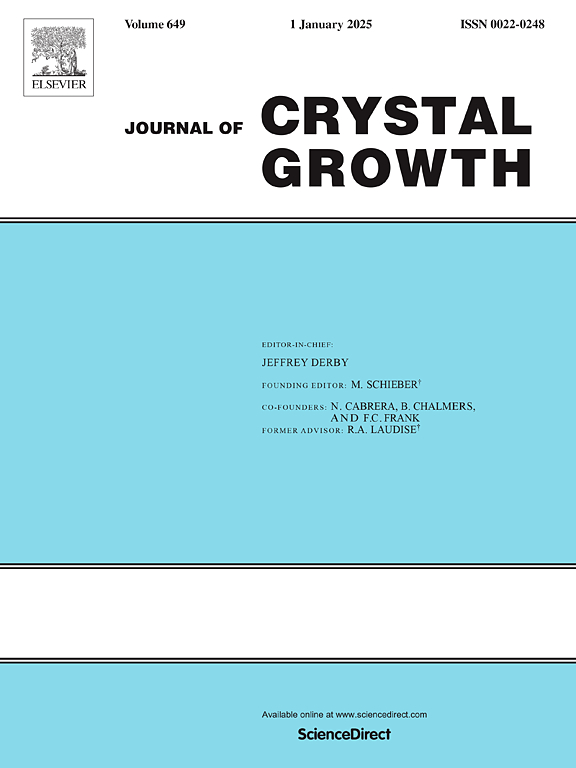蓝宝石(0001)衬底外延SnO2薄膜中多晶的鉴定
IF 2
4区 材料科学
Q3 CRYSTALLOGRAPHY
引用次数: 0
摘要
本研究采用同步x射线衍射(XRD)和透射电子显微镜(TEM)相结合的方法,利用射频粉末溅射技术鉴定了蓝宝石(0001)衬底上沉积的SnO2薄膜的多晶态。广泛的非镜面布拉格峰,包括高阶反射,通过高分辨率的平面内XRD分析进行了精确的相识别。显然,在沉积膜中存在正交柱长石(C-SnO2)和四方金红石(R-SnO2)相。由于两个相位都沿着表面法线与它们的(200)平面对齐,它们的面外Qz分量看起来几乎相同。然而,平面内的Qx和Qy分量是可区分的。根据面内Bragg峰位置估计晶格常数,并确定超薄膜(<10 nm)中相应的应变状态。在生长早期,由于扩展域匹配外延,C-SnO2和R-SnO2结构域分别表现出相反的应变-压缩应变和拉伸应变,这适应了晶格失配并控制了每个晶型的稳定性。两相在原子尺度上的共存进一步得到了截面高分辨率TEM分析的支持。这些发现为多晶的应变驱动稳定和对称不匹配衬底上外延SnO2薄膜的结构演变提供了新的见解。本文章由计算机程序翻译,如有差异,请以英文原文为准。
Identification of polymorphs in epitaxial SnO2 thin films deposited on sapphire (0001) substrates
In this study, synchrotron X-ray diffraction (XRD) and transmission electron microscopy (TEM) methods were combined to identify polymorphs in SnO2 thin films deposited on sapphire (0001) substrates using radio-frequency powder sputtering. A wide range of off-specular Bragg peaks—including higher-order reflections—were examined via high-resolution, in-plane XRD analyses for precise phase identification. Evidently, the orthorhombic columbite (C-SnO2) and tetragonal rutile (R-SnO2) phases coexisted in the as-deposited films. Because both the phases were aligned with their (200) planes along the surface normal, their out-of-plane Qz components appeared nearly identical. However, the in-plane Qx and Qy components were distinguishable. The lattice constants were estimated from the in-plane Bragg peak positions, and the corresponding strain states in ultrathin films (<10 nm) were determined. In the early stage of growth, the C-SnO2 and R-SnO2 domains exhibited opposing strains—compressive and tensile strains, respectively—because of extended domain matching epitaxy, which accommodated lattice mismatch and governed the stabilization of each polymorph. The coexistence of the two phases at the atomic scale was further supported by cross-sectional high-resolution TEM analysis. These findings provide new insights into the strain-driven stabilization of polymorphs and the structural evolution of epitaxial SnO2 thin films on symmetry-mismatched substrates.
求助全文
通过发布文献求助,成功后即可免费获取论文全文。
去求助
来源期刊

Journal of Crystal Growth
化学-晶体学
CiteScore
3.60
自引率
11.10%
发文量
373
审稿时长
65 days
期刊介绍:
The journal offers a common reference and publication source for workers engaged in research on the experimental and theoretical aspects of crystal growth and its applications, e.g. in devices. Experimental and theoretical contributions are published in the following fields: theory of nucleation and growth, molecular kinetics and transport phenomena, crystallization in viscous media such as polymers and glasses; crystal growth of metals, minerals, semiconductors, superconductors, magnetics, inorganic, organic and biological substances in bulk or as thin films; molecular beam epitaxy, chemical vapor deposition, growth of III-V and II-VI and other semiconductors; characterization of single crystals by physical and chemical methods; apparatus, instrumentation and techniques for crystal growth, and purification methods; multilayer heterostructures and their characterisation with an emphasis on crystal growth and epitaxial aspects of electronic materials. A special feature of the journal is the periodic inclusion of proceedings of symposia and conferences on relevant aspects of crystal growth.
 求助内容:
求助内容: 应助结果提醒方式:
应助结果提醒方式:


